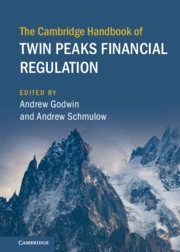Book contents
- The Cambridge Handbook of Twin Peaks Financial Regulation
- The Cambridge Handbook of Twin Peaks Financial Regulation
- Copyright page
- Contents
- Figures
- Tables
- Contributors
- Foreword
- Acknowledgements
- 1 Introduction
- Part I Surveying the Terrain
- 2 The Three Episodes of Twin Peaks
- 3 Reflections on Twenty Years of Regulation under Twin Peaks
- 4 Twin Peaks and Central Banks
- Part II The Trek towards Twin Peaks
- Part III Different Topographies
- Part IV Seismic Activity and Fault Lines
3 - Reflections on Twenty Years of Regulation under Twin Peaks
from Part I - Surveying the Terrain
Published online by Cambridge University Press: 24 June 2021
- The Cambridge Handbook of Twin Peaks Financial Regulation
- The Cambridge Handbook of Twin Peaks Financial Regulation
- Copyright page
- Contents
- Figures
- Tables
- Contributors
- Foreword
- Acknowledgements
- 1 Introduction
- Part I Surveying the Terrain
- 2 The Three Episodes of Twin Peaks
- 3 Reflections on Twenty Years of Regulation under Twin Peaks
- 4 Twin Peaks and Central Banks
- Part II The Trek towards Twin Peaks
- Part III Different Topographies
- Part IV Seismic Activity and Fault Lines
Summary
This chapter reviews the philosophy that underpinned the introduction of Twin Peaks in Australia in 1998, the lessons that have been learned from the Australian experience and from the global financial crisis, and the way in which those experiences might have shaped the recommendations of the Australian Financial System Inquiry (which recommended Twin Peaks) were it being undertaken today, rather than two decades ago. The chapter concludes by noting that no regulatory architecture is perfect, and no architecture is likely to be optimal under all circumstances; architecture is not an end in itself. A good architecture does not guarantee good regulation; more than anything else good regulation requires good quality regulators. A strong architecture is one that supports good regulators by establishing clarity of objectives, minimising conflicts, empowering the regulators to act, and doing as much as possible to facilitate a common approach to risk across the financial sector. While the Twin Peaks architecture provides such support, it is a necessary, but not sufficient, condition for good regulation.
- Type
- Chapter
- Information
- Publisher: Cambridge University PressPrint publication year: 2021
- 1
- Cited by

